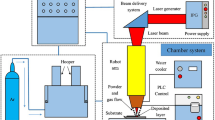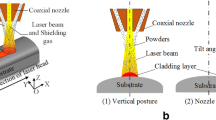Abstract
This research investigated the influence of different processing parameters in curved surface multi-track laser cladding with curve paths. Mathematical models of flatness ratio, incomplete fusion, and pore area in the clad were developed by central composite design with altering the input laser power, scanning speed, gas flow, and overlapping rate. Response surface methodology was used to analyze the correlation of different processing parameters affecting the selected responses. A clad with better flatness ratio was achieved by properly increasing the laser power and gas flow while reducing the overlapping rate. Appropriately increasing the laser power and overlapping rate while reducing the scanning speed and gas flow effectively diminished the incomplete fusion. Less pore area in the clad was obtained by appropriately increasing the laser power and overlapping rate while reducing the scanning speed and gas flow. Afterwards, desired processing parameters set was obtained by the optimization with the target of maximizing the flatness ratio and also minimizing the incomplete fusion and pore area. Experimental validation with this processing parameter setup provided satisfactory clad, and the error rate for the flatness ratio, incomplete fusion, and pore area was 1.708%, 5.714%, and 6.522%, respectively. This paper provides the theoretical guidance for the prediction and control of the flatness ratio, incomplete fusion, and pore area in curved surface multi-track laser cladding with curve paths.
















Similar content being viewed by others
References
Song B, Yu T, Jiang X, Xi W (2019) Numerical model of transient convection pattern and forming mechanism of molten pool in laser cladding. Numerical Heat Transfer, Part A: Applications 75(12):855–873
Li Y, Dong S, Yan S, Liu X, He P, Xu B (2018) Surface remanufacturing of ductile cast iron by laser cladding Ni-Cu alloy coatings. Surf Coat Technol 347:20–28
Jiang Y, Li J, Juan Y, Lu Z, Jia W (2019) Evolution in microstructure and corrosion behavior of AlCoCrxFeNi high-entropy alloy coatings fabricated by laser cladding. J Alloys Compd 775:1–14
Sun SD, Barr C, Brandt M (2018) In situ control of tempered martensite during laser cladding repair of aero-grade 300M steel using AISI 420 stainless steel powder. Journal of Laser Applications 30(3):032502
Liu H, Qin X, Huang S, Hu Z, Ni M (2018) Geometry modeling of single track cladding deposited by high power diode laser with rectangular beam spot. Opt Lasers Eng 100:38–46
Pant P, Chatterjee D, Nandi T, Samanta SK, Lohar AK, Changdar A (2019) Statistical modelling and optimization of clad characteristics in laser metal deposition of austenitic stainless steel. J Braz Soc Mech Sci Eng 41(7):283
Gusev D, Lyukhter A Influence of technological parameters on the geometry of single-track laser clad nickel based alloy on grey cast iron substrate. In: Journal of Physics: Conference Series, 2017. vol 1. IOP Publishing, p 012037
Shi X, Ma S, Liu C, Wu Q (2017) Parameter optimization for Ti-47Al-2Cr-2Nb in selective laser melting based on geometric characteristics of single scan tracks. Opt Laser Technol 90:71–79
Reddy L, Preston SP, Shipway P, Davis C, Hussain T (2018) Process parameter optimisation of laser clad iron based alloy: predictive models of deposition efficiency, porosity and dilution. Surf Coat Technol 349:198–207
Alvarez P, Montealegre M, Pulido-Jiménez J, Arrizubieta J (2018) Analysis of the process parameter influence in laser cladding of 316L stainless steel. Journal of Manufacturing and Materials Processing 2(3):55
Wen P, Feng Z, Zheng S (2015) Formation quality optimization of laser hot wire cladding for repairing martensite precipitation hardening stainless steel. Opt Laser Technol 65:180–188
Lian G, Zhang H, Zhang Y, Tanaka ML, Chen C, Jiang J (2019) Optimizing processing parameters for multi-track laser cladding utilizing multi-response Grey relational analysis. Coatings 9(6):356
Olakanmi E, Nyadongo S, Malikongwa K, Lawal S, Botes A, Pityana SL (2019) Multi-variable optimisation of the quality characteristics of fiber-laser cladded Inconel-625 composite coatings. Surf Coat Technol 357:289–303
Güvercin S, Yildiz A (2018) Optimization of cutting parameters using the response surface method. Sigma 36(1):113–121
Lian G, Yao M, Zhang Y, Chen C (2018) Analysis and prediction on geometric characteristics of multi-track overlapping laser cladding. Int J Adv Manuf Technol 97(5–8):2397–2407
Urbanic R, Saqib S, Aggarwal K (2016) Using predictive modeling and classification methods for single and overlapping bead laser cladding to understand bead geometry to process parameter relationships. J Manuf Sci Eng 138(5):051012
Xiong Z, G-x C, X-y Z (2009) Effects of process variables on interfacial quality of laser cladding on aeroengine blade material GH4133. J Mater Process Technol 209(2):930–936
Zhang N, Liu W, Deng D, Tang Z, Liu X, Yan Z, Zhang H (2018) Effect of electric-magnetic compound field on the pore distribution in laser cladding process. Opt Laser Technol 108:247–254
Zhou S, Zeng X, Hu Q, Huang Y (2008) Analysis of crack behavior for Ni-based WC composite coatings by laser cladding and crack-free realization. Appl Surf Sci 255(5):1646–1653
Atabaki MM, Ma J, Liu W, Kovacevic R (2015) Pore formation and its mitigation during hybrid laser/arc welding of advanced high strength steel. Mater Des 67:509–521
Yang Z, Wang A, Weng Z, Xiong D, Ye B, Qi X (2017) Porosity elimination and heat treatment of diode laser-clad homogeneous coating on cast aluminum-copper alloy. Surf Coat Technol 321:26–35
Hu J, Setiadinata B, Aarholt T, Garner A, Vilalta-Clemente A, Partezana J, Frankel P, Bagot P, Lozano-Perez S, Wilkinson A Understanding corrosion and hydrogen pickup of zirconium fuel cladding alloys: the role of oxide microstructure, porosity, suboxides, and second-phase particles. In: Zirconium in the nuclear industry: 18th international symposium, 2018. ASTM International,
Zhou S, Dai X, Zheng H (2012) Microstructure and wear resistance of Fe-based WC coating by multi-track overlapping laser induction hybrid rapid cladding. Opt Laser Technol 44(1):190–197
Zhang Q, He J, Liu W, Zhong M (2003) Microstructure characteristics of ZrC-reinforced composite coating produced by laser cladding. Surf Coat Technol 162(2–3):140–146
Zhou C, Zhao S, Wang Y, Liu F, Gao W, Lin X (2015) Mitigation of pores generation at overlapping zone during laser cladding. J Mater Process Technol 216:369–374
Katayama S, Seto N, Mizutani M, Matsunawa A (2000) Formation mechanism of porosity in high power YAG laser welding. Laser materials processing, ICALEO 2000 proceedings 89:200016
Funding
This study was supported by the National Natural Science Foundation of China, grant no. 51575110. This study is also supported by the Public Service Platform for Technical Innovation of Machine Tool Industry in Fujian Province at Fujian University of Technology.
Author information
Authors and Affiliations
Corresponding author
Additional information
Publisher’s note
Springer Nature remains neutral with regard to jurisdictional claims in published maps and institutional affiliations.
Rights and permissions
About this article
Cite this article
Lian, G., Zhang, H., Zhang, Y. et al. Control and prediction of forming quality in curved surface multi-track laser cladding with curve paths. Int J Adv Manuf Technol 106, 3669–3682 (2020). https://doi.org/10.1007/s00170-019-04893-7
Received:
Accepted:
Published:
Issue Date:
DOI: https://doi.org/10.1007/s00170-019-04893-7




